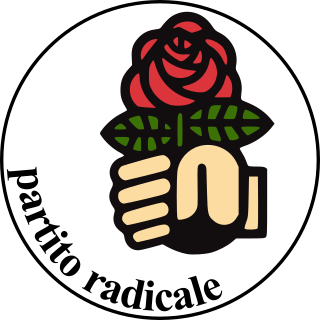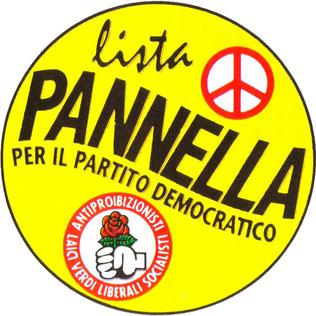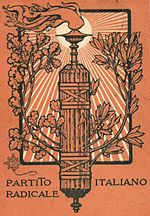
The Transnational Radical Party (TRP), whose official name is Nonviolent Radical Party, Transnational and Transparty (NRPTT), is a political association of citizens, members of parliament and members of government of various national and political backgrounds who intend to adopt nonviolent means to create an effective body of international law with respect for individuals, human, civil and political rights, as well as the affirmation of democracy and political freedom in the world. The TRP does not participate in elections, and despite being named "party", is a non-governmental organization (NGO), with consultative status at the Economic and Social Council (ECOSOC) of the United Nations (UN) since 1995, adept in building synergies among political forces aimed at achieving the goals of its congressional motions.

The Radical Party was a liberal and libertarian political party in Italy.

The Italian Radicals is a liberal and libertarian political party in Italy.
Liberalism and radicalism have played a role in the political history of Italy since the country's unification, started in 1861 and largely completed in 1871, and currently influence several leading political parties.

Marco Pannella was an Italian politician, journalist and activist. He was well known in his country for his nonviolence and civil rights' campaigns, like the right to divorce, the right to abortion, the legalization of cannabis and the abolition of nuclear power. Internationally, he supported human rights and self-determination causes, like the Tibetan independence and persecution of Christians in Vietnam.

The Italian Socialist Party was a social-democratic and democratic-socialist political party in Italy, whose history stretched for longer than a century, making it one of the longest-living parties of the country. Founded in Genoa in 1892, the PSI was from the beginning a big tent of Italy's political left and socialism, ranging from the revolutionary socialism of Andrea Costa to the Marxist-inspired reformist socialism of Filippo Turati and the anarchism of Anna Kuliscioff. Under Turati's leadership, the party was a frequent ally of the Italian Republican Party and the Italian Radical Party at the parliamentary level, while lately entering in dialogue with the remnants of the Historical Left and the Liberal Union during Giovanni Giolitti's governments to ensure representation for the labour movement and the working class. In the 1900s and 1910s, the PSI achieved significant electoral success, becoming Italy's first party in 1919 and during the country's Biennio Rosso in 1921, when it was victim of violent paramilitary activities from the far right, and was not able to move the country in the revolutionary direction it wanted.

The Italian Liberal Party was a liberal political party in Italy.

General elections were held in Italy on 16 November 1919. The fragmented Liberal governing coalition lost the absolute majority in the Chamber of Deputies, due to the success of the Italian Socialist Party and the Italian People's Party.

General elections were held in Italy on 15 May 1921. It was the first election in which the recently acquired regions of Trentino-Alto Adige, Venezia Giulia, Zara and Lagosta island elected deputies, many of whom were from the Germanic and South Slavic ethnic groups.

The Italian Reformist Socialist Party was a social-democratic political party in Italy.

The Italian People's Party, also translated as Italian Popular Party, was a Christian-democratic political party in Italy inspired by Catholic social teaching. It was active in the 1920s, but fell apart because it was deeply split between the pro- and anti-fascist elements. Its platform called for an elective Senate, proportional representation, corporatism, agrarian reform, women's suffrage, political decentralisation, independence of the Catholic Church, and social legislation.

The Pannella List is a liberal and libertarian association, which was also the electoral list of the Italian Radicals between 1992 and 1999, when it was replaced by the Bonino List.
The Historical Far Left, originally known as Far Left, Radical Extreme, simply The Extreme, or Party of Democracy, was a left-wing parliamentary group and coalition of Radical, Republican and Socialist politicians in Italy during the second half of the 19th century. Formerly known as the extreme wing of the Historical Left before the unification of Italy, it became a separate group when the more moderate branch of the Left accepted the leadership of the House of Savoy to build the new Italian state.

The Italian Democratic Liberal Party was a liberal and radical political party in Italy during the earlier decades of the 20th century. Initially, the party was an alliance between progressive liberals, called Liberals, Democrats and Radicals.
General elections were held in Italy on 26 October 1913, with a second round of voting on 2 November. The Liberals narrowly retained an absolute majority in the Chamber of Deputies, while the Radical Party emerged as the largest opposition bloc. Both groupings did particularly well in Southern Italy, while the Italian Socialist Party gained eight seats and was the largest party in Emilia-Romagna. However, the election marked the beginning of the decline of Liberal establishment.
The Constitutional Democratic Party was a social-liberal political party in Italy.
The Combatants' Party was a nationalist political party in Italy, whose aim was to protect the interests of First World War veterans.
The Democratic Party was a social liberal political party in Italy.

The Liberal Union, simply and collectively called Liberals, was a political alliance formed in the first years of the 20th century by the Italian Prime Minister and leader of the Historical Left Giovanni Giolitti. The alliance was formed when the Left and the Right merged in a single centrist and liberal coalition which largely dominated the Italian Parliament.
Events from the year 1913 in Italy.












